L16- Greenhouse Gas Removal Using Enhanced Weathering
Guest lecture→ David Beerling
Leverhulme Centre for Climate Change Mitigation→ £10million climate change research institute
work is focused on taking CO2 out of the atmosphere to mitigate climate change
Past:
last 100 years→ due to burning fossil fuels, now about 40Gt CO2 released every year
what we need to do over the next 100 years→
transition to clean energy
reduce emissions
need to take CO2 out of the atmosphere
some sectors will be really hard to decarbonise e.g. agriculture and transport
need to take it out because there is too much in there
→ need to research now
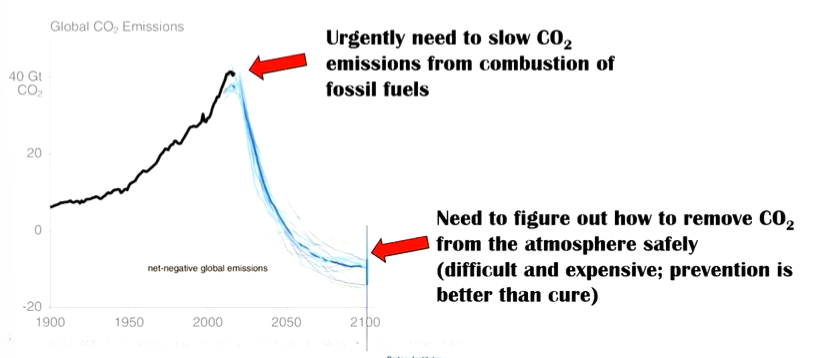
Enhanced Weathering-
CO2 removal technology
maize plants growing in field, add crushed silicate rocks (basalt)- have higher reactive surface areas, react quickly in soil
CO2 and H20 in the soil make carbonic acid, wears the rocks, releases bicarbonate ions which is CO2 fixed in a soluble form
bicarbonate ions are transferred into the oceans over time
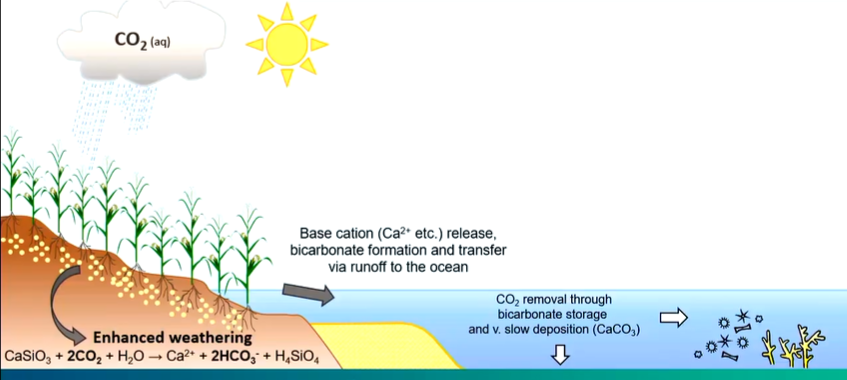
helps reduce ocean acidification→ CO2 dissolves into ocean
harnesses natural reactions that have been stabilising the climate for millions of years
is deployable at scale within a decade or two→ know how to mine and apply rocks already
co-deployable with other CO2 removeable strategies
Literature-
wrote this out in 2018- outlined that it is CO2 removal but also improves soil health and food security
had mixed responses to this
Co-benefits of enhanced rock weathering:
reverse soil acidification→
apply lime for pH management for soil to take up nutrients
using rocks instead increases yield and capture carbon
reverse silica stripping→
food crops accumulate silica, but take silica off fields when removing crops, reduces ability to defend themselves
put down silicate rocks to replenish pool
replenish other micronutrients→
e.g. phosphorus, potassium, molybdenum
are critical for crop health
reduce use of fertilisers and cost
improve soil health→
stimulate root growth, fungi
→ increases crop production and crop protection
How it works:
basalt combines with co2 and water→ bicarbonate→ drains into ocean
managing pH→ improve nutrient uptake→ increases yields
do due diligence→ check fate of metals in feedstock
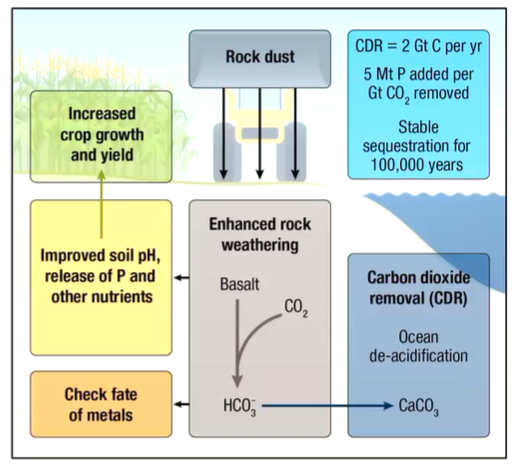
3 wins of ERW:
CO2 removal
mitigation of other GHG emissions e.g. nitrous oxide
avoid GHG emissions e.g. reducing need for fertilisers reduces amount of phosphorous and potassium used
Benefits of ERW:
unlimited carbon sequestration capacity
uses existing technologies
is synergistic with other land uses
provides social justice opportunities→ increase value of own land, job opportunities for those losing jobs in fossil fuels
Carbon sequestration of different CDR techniques:
in 2015, didn’t know how much co2 could be removed or costs with different techniques:
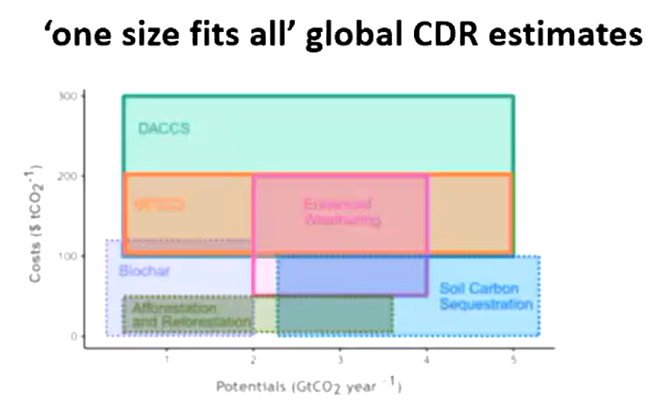
first few years of project→
develop numerical modelling tools to understand this
apply to individual nations
couple models with climate models, including constraints of resources
advances→
how quickly are rocks used up
how age cohorts are managed
making nitric acid
resource availability
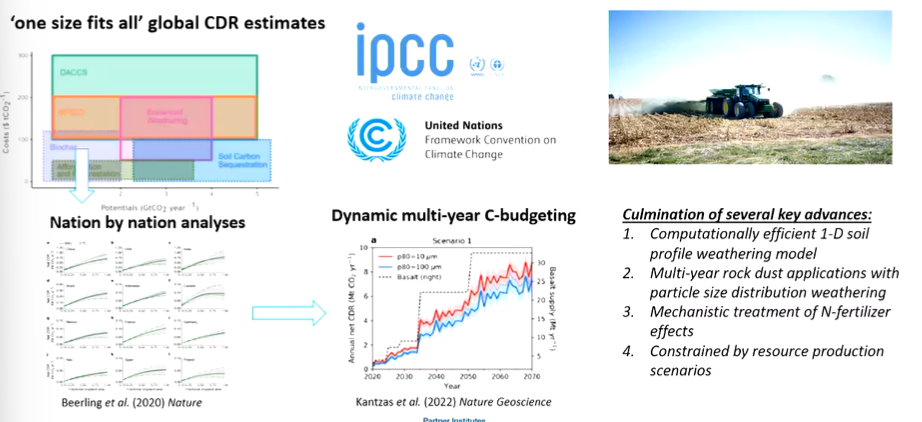
UK:
aim to be net-zero by 2050
understanding the potential of ERW with UK crops:
found that we could meet half of net zero emissions using ERW with UK crops
net CO2 removal increases over time→ 8Mt of co2 per year (after accounting for emissions), with current mining rates
increasing mining rates→ using 150Mt of rocks takes net CO2 removal to 30-40Mt
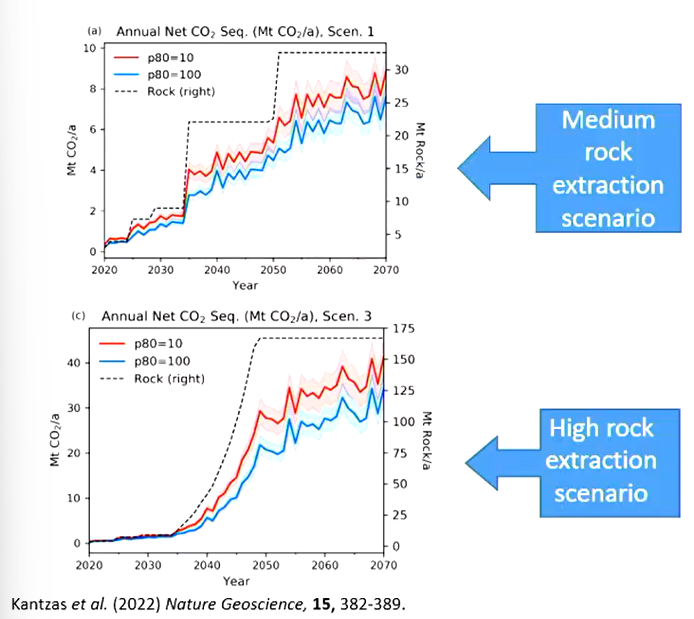
→ decisions centre around increasing mining industry in the UK→ issues for social scientists
particle size→ more grinding of rocks require more energy
80% of particles are less than or equal to 20 micrometres in diameter→ grinding rocks to 20 micrometres can get 10Mt removal by 2045 but if you leave them 10x bigger, can still get 10Mt removal a few years later
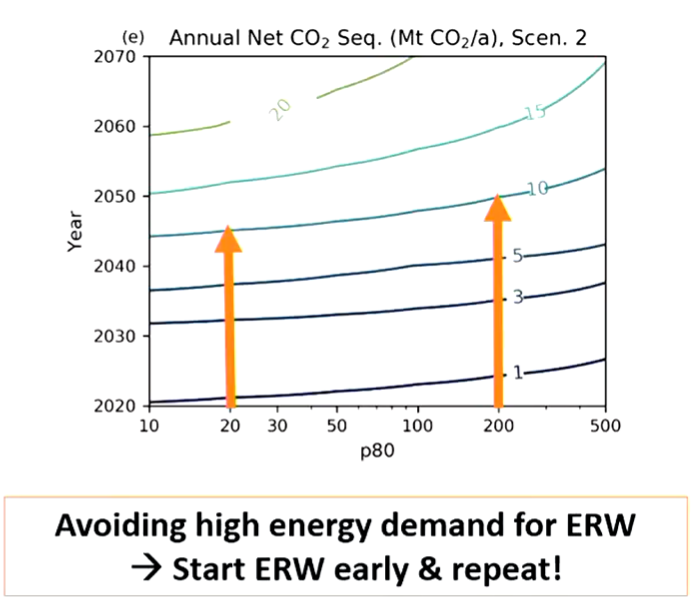
→ leaving them big reduces energy but can still get the same results a few years later
US:
Biden administration released a long-term strategy report to get US to net-zero but ignored ERW as a strategy
made simulations to look at what the US could do e.g. states on the East coast currently produce high amounts of basalt, moving this onto US corn belt
by 2050, could get between 0.2-0.4Gt of CO2 removal, whilst also improving soils
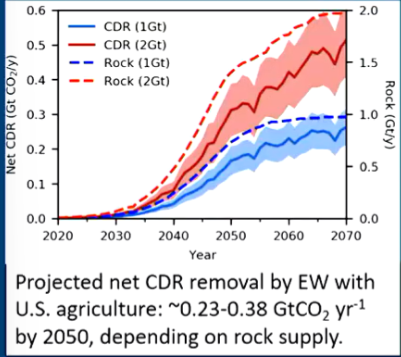
are there potentials for re-release of CO2 through this?
found that there is only 5% leakage, not a huge loss
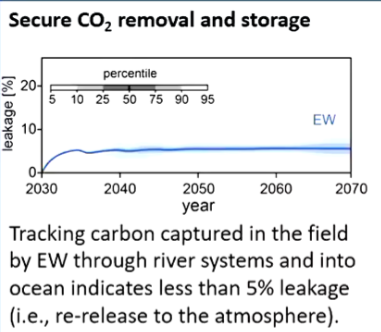
→ could offer 30-60% of their engineered CDR goals
Field sites:
have set up a global network of field sites:
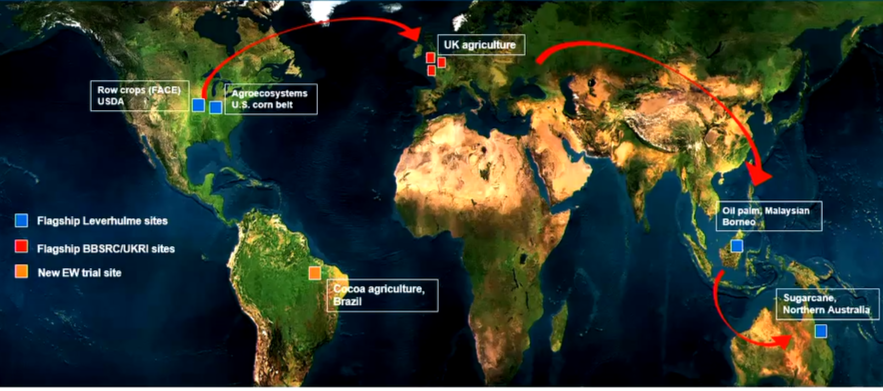
Corn belt trials, US:
have added this every year since 2017
grow crops on rotation→ maize- requires high nitrogen fertiliser, soybean- fixes nitrogen and lowers potential of pests
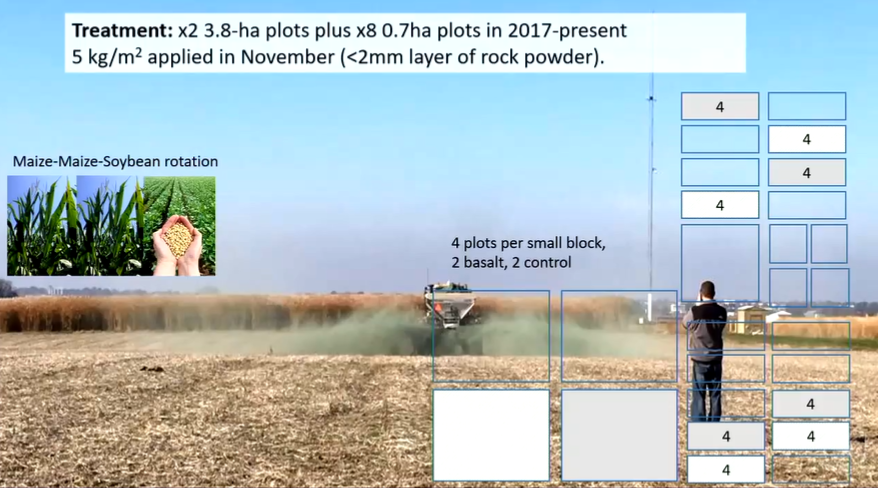
measuring co2 released→
measure bicarbonate ions- difficult to do
measure how many ions of calcium have been lost from feedstock and use charge balance to work out how many bicarbonate ions have been made
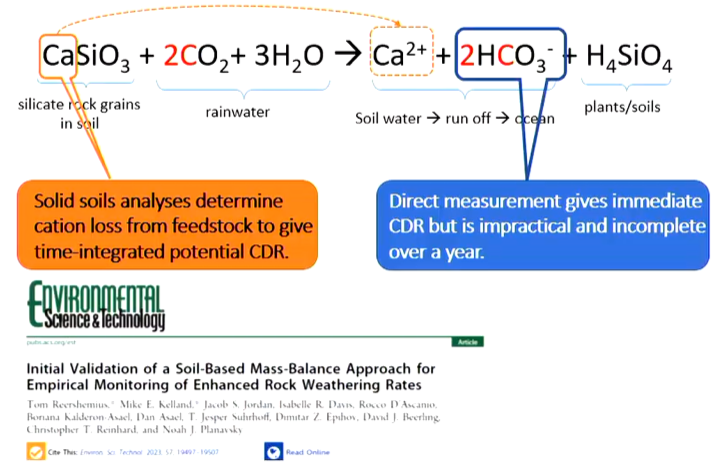
→ have found a way to use isotope dilution mass spectrometry
applying second technique:
rates of co2 removal→ can see how noisy soils are, is increasing
more rocks, the cumulative CO2 removal increases to 20T per hectare
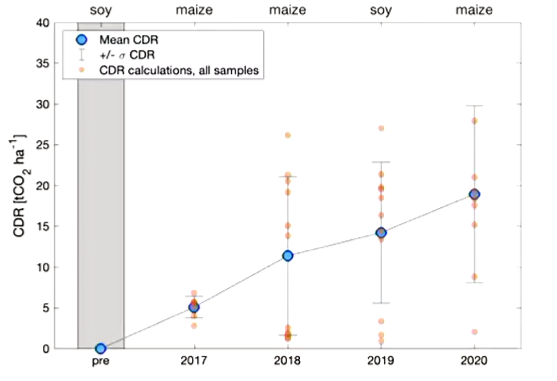
increasing number of samples, annual rate of co2 removal stabilises
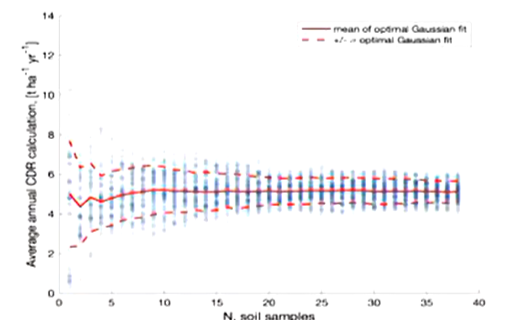
→ can optimise sample strategy in the field
pH→
control- adding fertilisers reduces pH
applying basalt- pH increases in soil, similar response with lower depth of soils
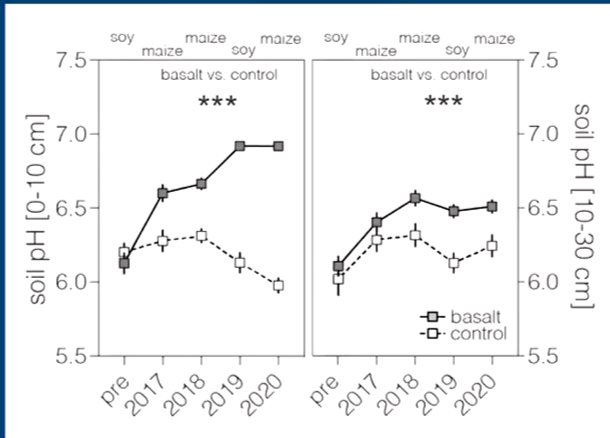
yield→
increase in yield by 8%, second year no increase, increase in 16% in soy, 12% increase in maize
big benefit initially, decays away, is better than liming though
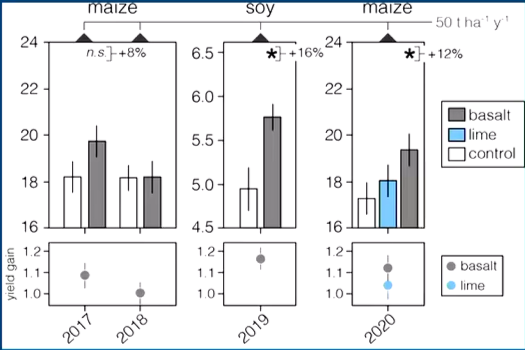
→ basalt provides additional nutrients for crop growth
can see reduction in nitrous oxide in 7/8 years

air quality→
reduction in daily average of ozone in the corn belt by doing enhanced weathering at scale
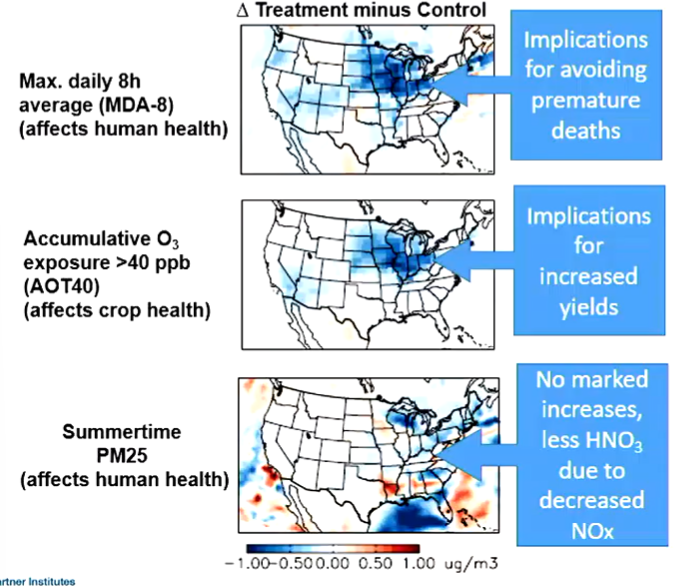
→ interesting feedbacks on air quality
yield increases of both maize and soybean by reducing future ozone increases:
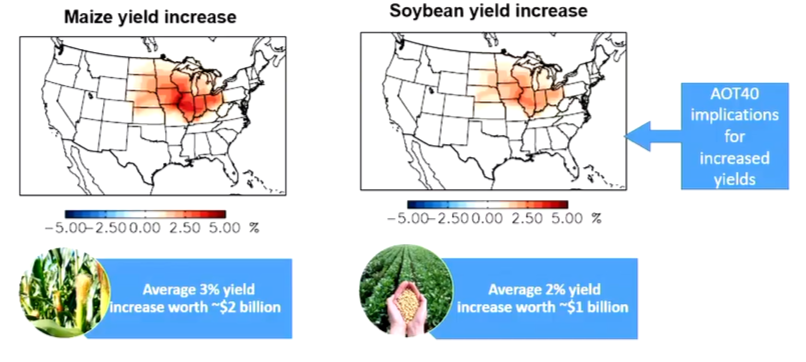
→ non-trivial increases by doing this at scale
how does increasing CO2 in plants affect weathering:
hypotheses→ all show that elevated CO2 would increase mineral weathering
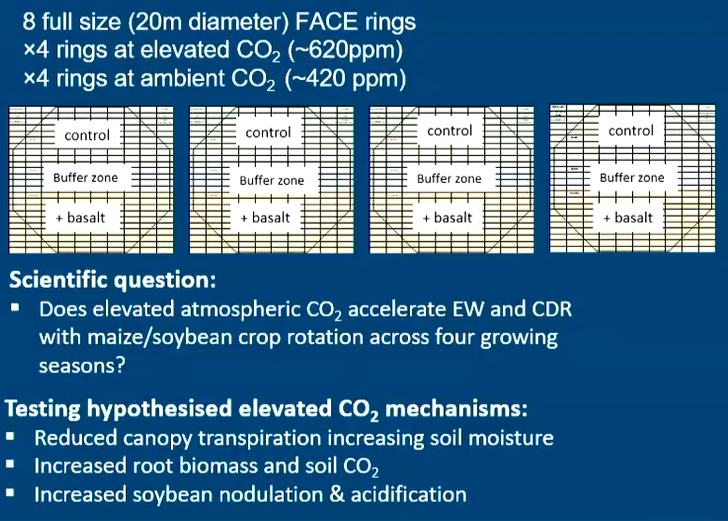
in the field→ hypotheses are broadly supported: as CO2 goes up, there is a strong feedback on crop production that drives enhanced weathering
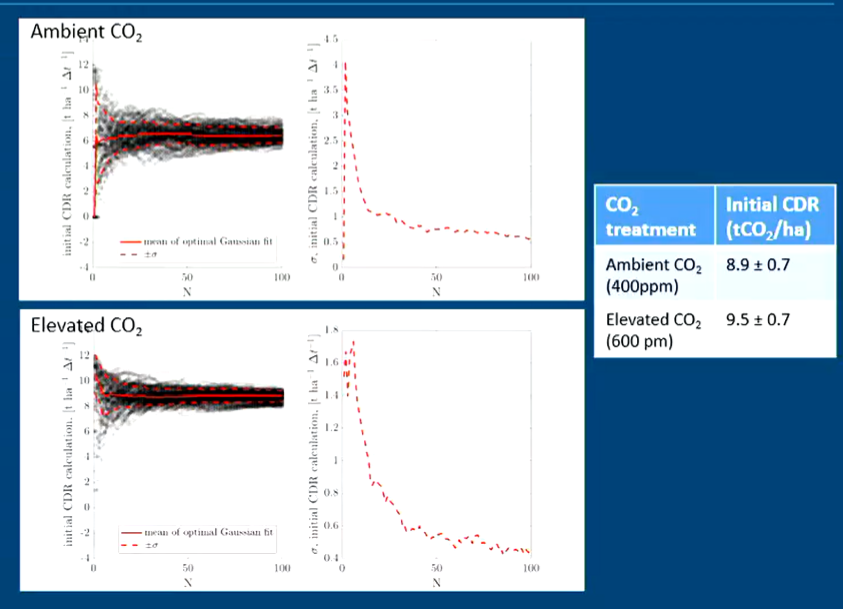
UK EW Trials:
funded by UK government
4 aims→
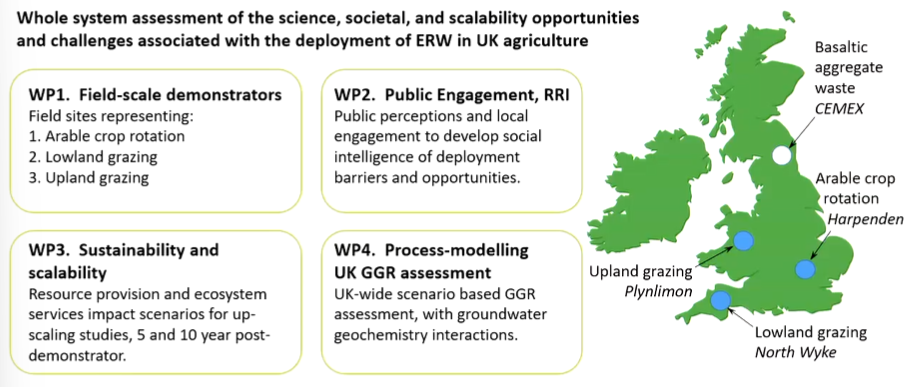
arable crops→
study site:
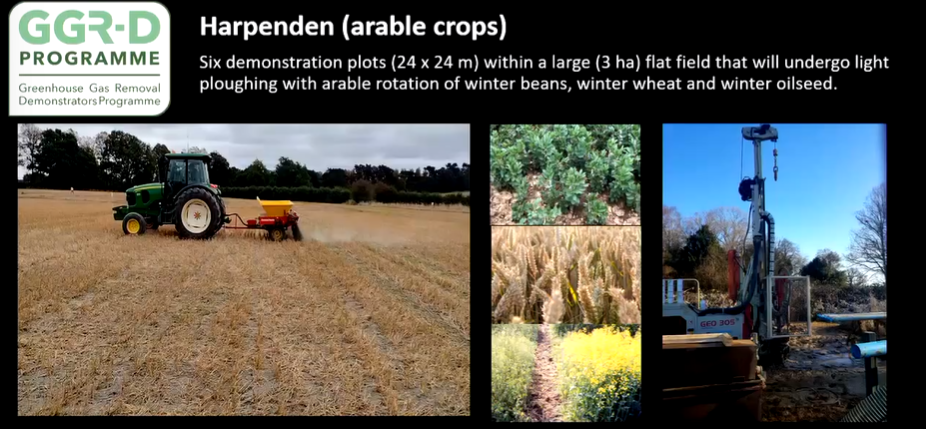
results→
applying basalt increases pH
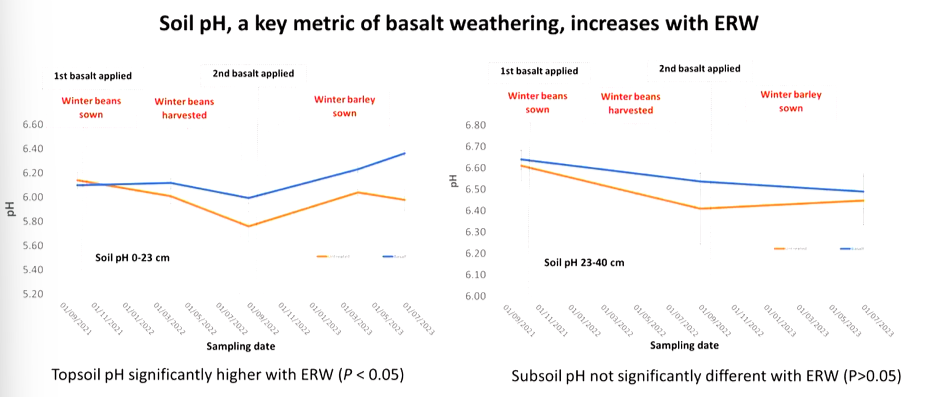
applying basalt increases higher alkalinity and in ions
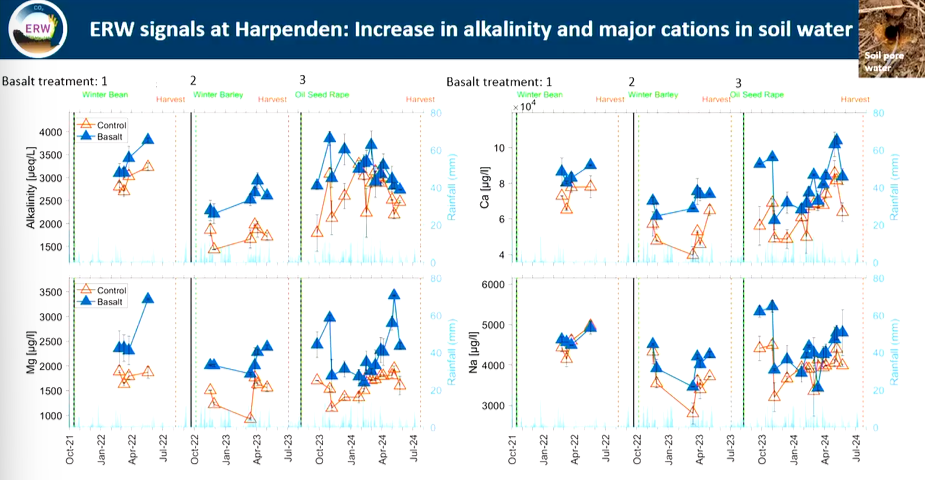
all trace elements show no significant increase after treatment for three years, only exception is molybdenum but disappeared
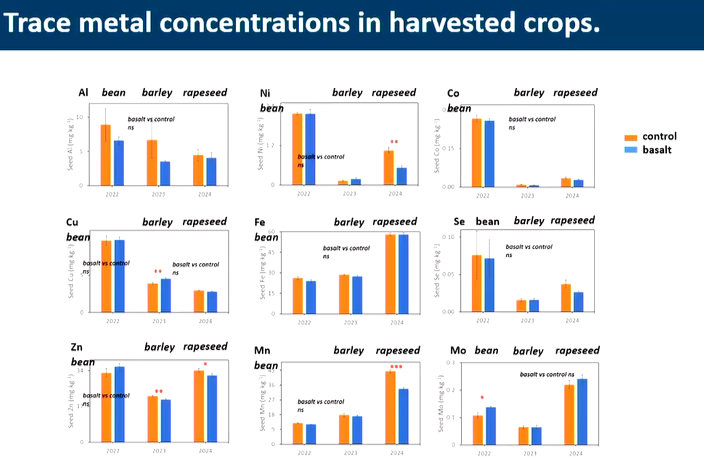
→ crops don’t accumulate heavy metals→ due diligence
no increases of any trace metals draining into the water
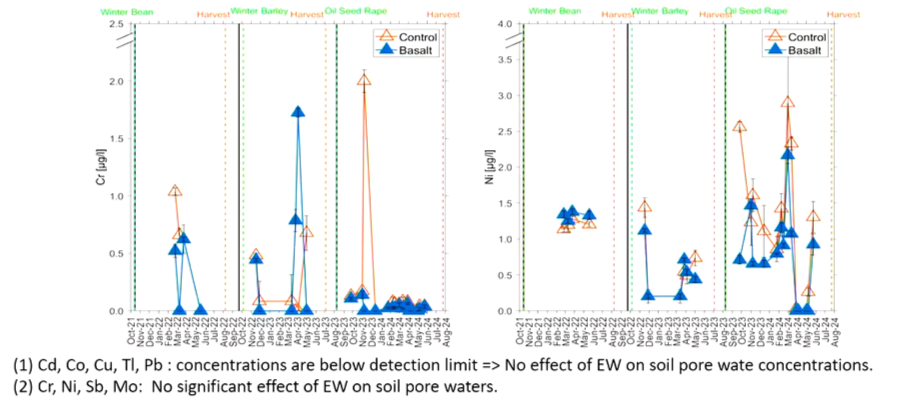
earthworms love basalt→ may have digestive enzymes to inject and break down the minerals
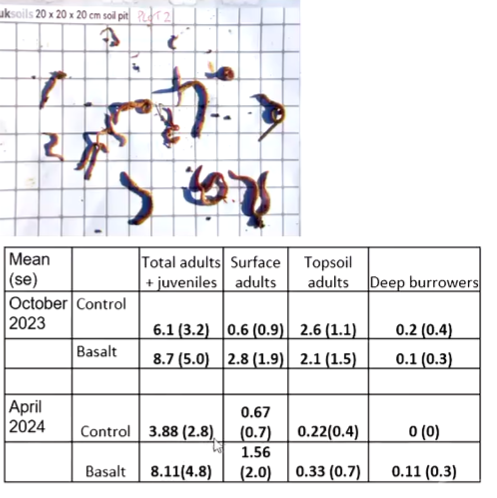
lowland pasture→
study site:
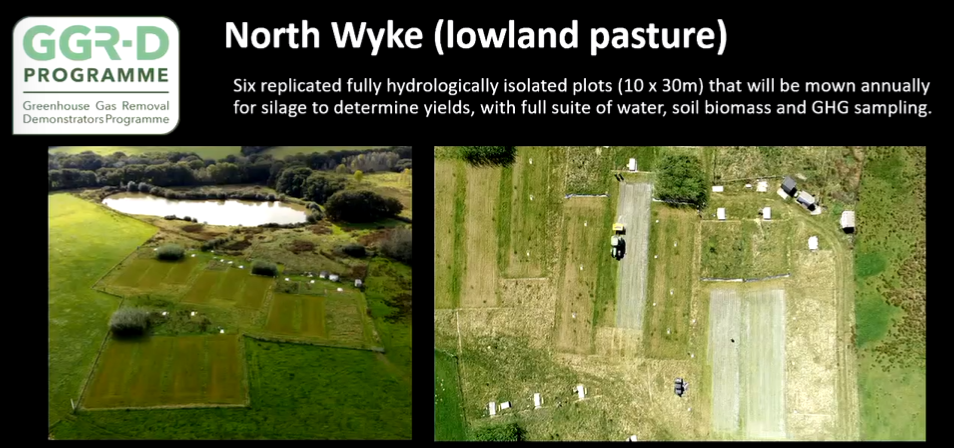
collected storm water and measured chemistry to tell about carbon capture→
2/3 storm events always had are higher pH in both 2023 and 2024
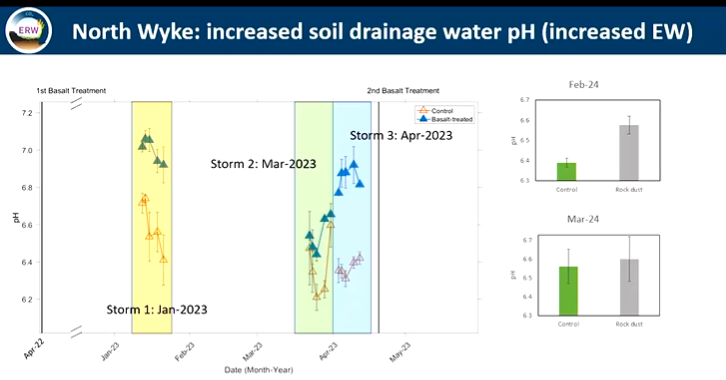
all storm events had higher alkalinity events in both 2023 and 2024
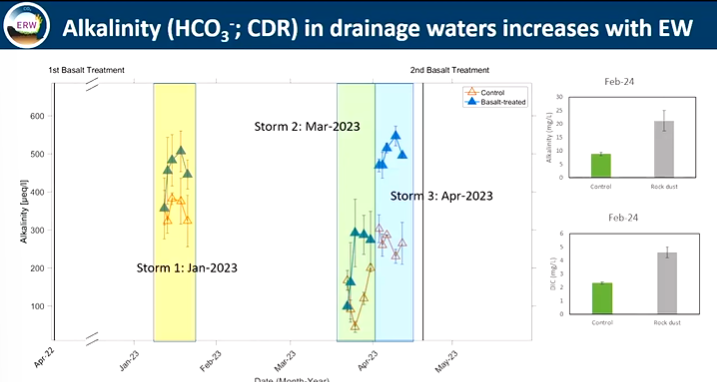
no increases in trace metals, slight decrease due to indirect pH effects
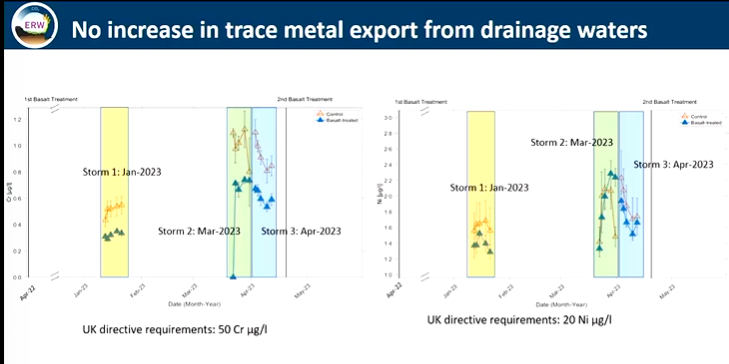
CO2 removal→ still in progress
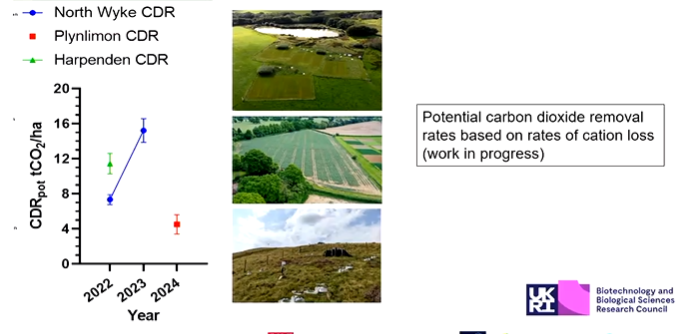
how do they know models are accurate?
benchmark against data
theory was 30-60Mt of CO2 a year and field results show it is actually 38-48Mt of CO2 a year
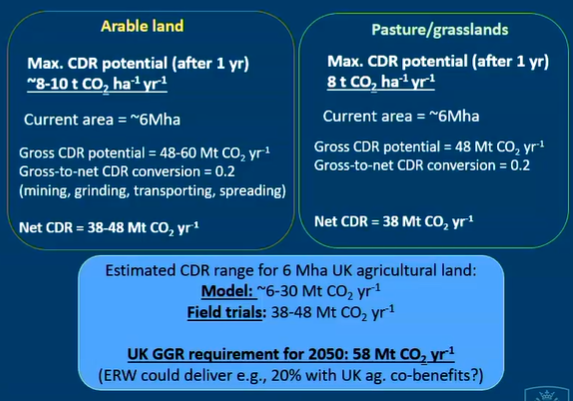
→ are in the right ballpark
Future-
20 commercial companies doing this worldwide
concern is are we measuring co2 removal accurately to sell CO2 credits on the markets?
is exciting but need to avoid the risk of the bottom→ assuming that CO2 is being removed
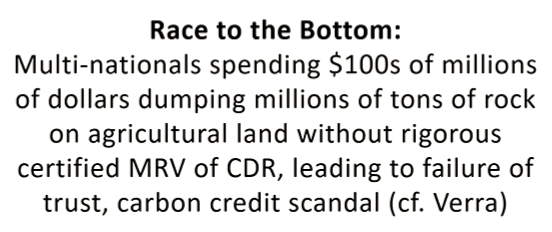
scandal happened with avoiding deforestation e.g. Verra boss stepping down over this
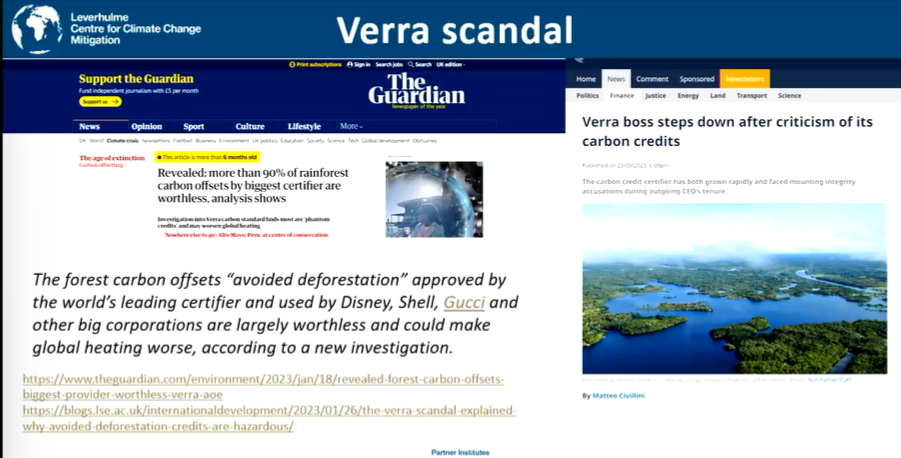
need a range of processes for the monitoring, reporting and verification of CO2
need numerical models to understand how much CDR we get once the rocks are put down and over time using
having an app that certifies amount of CDR-
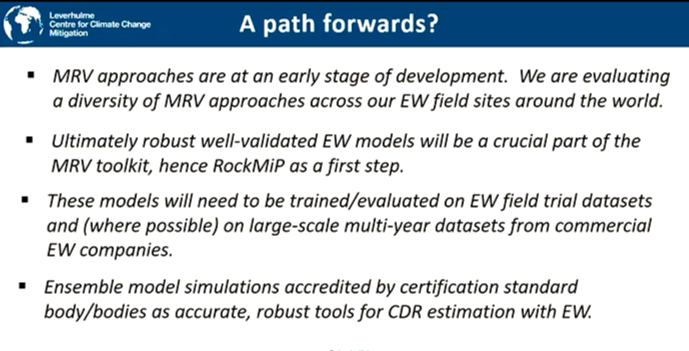
are currently making this:
put in details-
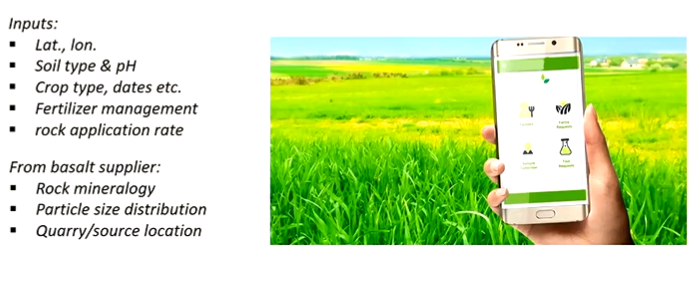
simulates changes-
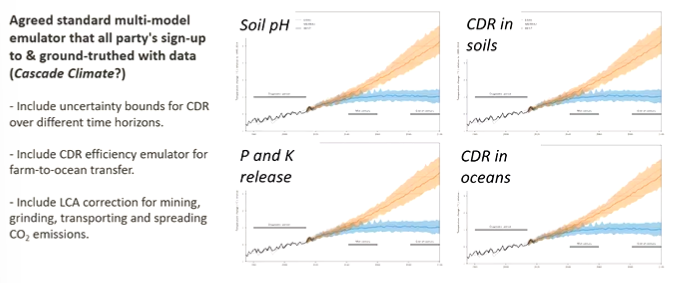
Conclusion-
enhanced weathering exploits what human societies have known for centuries- volcanic rocks are very good for farming
e.g. extinct volcano in Vietnam
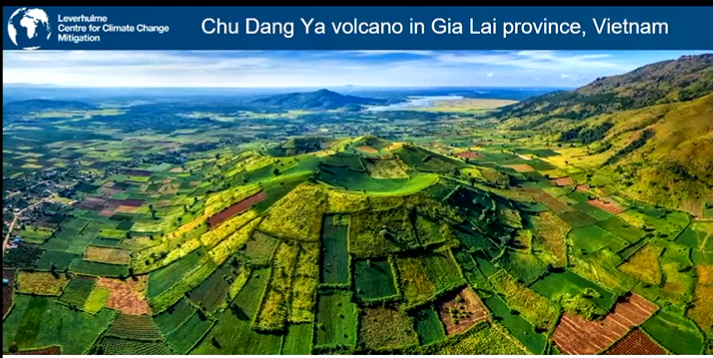
e.g. mount vesuvius- exploit nutrient rich volcanic rocks
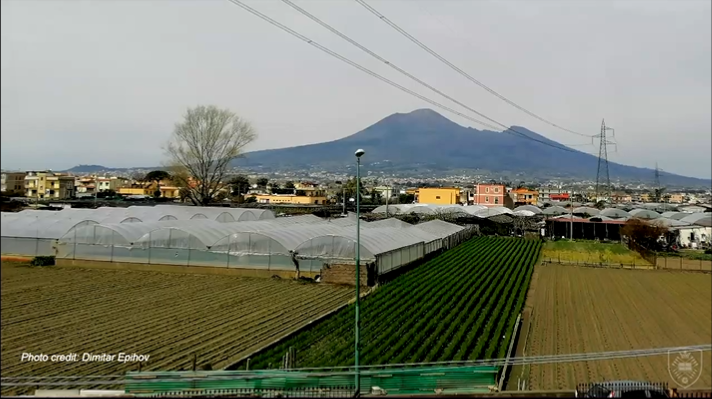
Questions-
basalt is the most abundant rock in the world→ will work best in tropics with high agriculture, high basalt, and perfect climate conditions
still need to reduce co2 emissions first, but need this research now to figure out which technologies will work